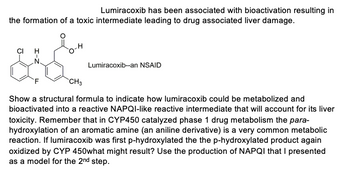
Chemistry
10th Edition
ISBN: 9781305957404
Author: Steven S. Zumdahl, Susan A. Zumdahl, Donald J. DeCoste
Publisher: Cengage Learning
expand_more
expand_more
format_list_bulleted
Question

Transcribed Image Text:Lumiracoxib has been associated with bioactivation resulting in
the formation of a toxic intermediate leading to drug associated liver damage.
Lumiracoxib--an NSAID
CH3
Show a structural formula to indicate how lumiracoxib could be metabolized and
bioactivated into a reactive NAPQI-like reactive intermediate that will account for its liver
toxicity. Remember that in CYP450 catalyzed phase 1 drug metabolism the para-
hydroxylation of an aromatic amine (an aniline derivative) is a very common metabolic
reaction. If lumiracoxib was first p-hydroxylated the the p-hydroxylated product again
oxidized by CYP 450what might result? Use the production of NAPQI that I presented
as a model for the 2nd step.

Transcribed Image Text:Would a structural alert have been appropriate for this structure? Justify your answer.
Expert Solution
This question has been solved!
Explore an expertly crafted, step-by-step solution for a thorough understanding of key concepts.
Step by stepSolved in 3 steps

Knowledge Booster
Learn more about
Need a deep-dive on the concept behind this application? Look no further. Learn more about this topic, chemistry and related others by exploring similar questions and additional content below.Similar questions
- (a) Which of the following drugs is more hydrolytically labile? Briefly explain. OH H OH مممممم CO₂H Clavulanic acid Loperamide (b) For each of the above drugs, indicate ONE functional group that is prone to oxidation. (c) One of the degradation products of clavulanic acid in an acidic environment is the following: HO₂C OH HN CO₂H Draw the mechanism of this degradation reaction.arrow_forwardChlorophyll, heme, vitamin B12, and a host of other substances are synthesized from porphobilinogen, which is itself formed from the condensation of two molecules of 5-aminolevulinate. The two 5-aminolevulinates are bound to lysine (Lys) residues in the enzyme, one in the enamine form and the other in the imine form. Condensation is thought to occur via a several step process, one of which is shown below. ÇO2 ÇO2 CO2 + NH3 NH3 H H3N 5-aminolevulinate (enamine form) 5-aminolevulinate (imine form) Porphobilinogen Draw curved arrows to illustrate the movement of electrons in this step of the reaction. Arrow-pushing Instructions CO2 CO2 CO2 CO2 :B BH* H-A H3N H3Ņarrow_forward9 HW Chapter 19 - Selected Exercises Question 2 of 8 0.6/1 (d) CH,CO3H Product(s): Draw Your Solution Save for Later Attempts: 0 of 3 used Submit Answer MacBook Air A) F12 F11 F10 F9 F7 delete & 8 Y enter IIarrow_forward
- Explain how phenacetin result in toxicity in this reaction( explain the reaction)??? Toxicity by Sulfation • Sufation of N-hydroxylarylamines can generate reactive electrophile that can lead to hepatotoxicity and Carcinogenicity HO, & OEt phenacetin 7.127 ỎEt sulfotransferase 03SQ ÕEt :OEt 7.145 ÖEt OEt Protein nucleophile Attack here is also possiblearrow_forwardhow the r-group affects the elimination, specifically E-1 reaction and how a different r-group would have a different effectarrow_forwardCF 3- Celecoxib -SO2NH2 Do the following synthesis reactions. ŞO₂NH₂ NHNH2 A +arrow_forward
arrow_back_ios
arrow_forward_ios
Recommended textbooks for you
 ChemistryChemistryISBN:9781305957404Author:Steven S. Zumdahl, Susan A. Zumdahl, Donald J. DeCostePublisher:Cengage Learning
ChemistryChemistryISBN:9781305957404Author:Steven S. Zumdahl, Susan A. Zumdahl, Donald J. DeCostePublisher:Cengage Learning ChemistryChemistryISBN:9781259911156Author:Raymond Chang Dr., Jason Overby ProfessorPublisher:McGraw-Hill Education
ChemistryChemistryISBN:9781259911156Author:Raymond Chang Dr., Jason Overby ProfessorPublisher:McGraw-Hill Education Principles of Instrumental AnalysisChemistryISBN:9781305577213Author:Douglas A. Skoog, F. James Holler, Stanley R. CrouchPublisher:Cengage Learning
Principles of Instrumental AnalysisChemistryISBN:9781305577213Author:Douglas A. Skoog, F. James Holler, Stanley R. CrouchPublisher:Cengage Learning Organic ChemistryChemistryISBN:9780078021558Author:Janice Gorzynski Smith Dr.Publisher:McGraw-Hill Education
Organic ChemistryChemistryISBN:9780078021558Author:Janice Gorzynski Smith Dr.Publisher:McGraw-Hill Education Chemistry: Principles and ReactionsChemistryISBN:9781305079373Author:William L. Masterton, Cecile N. HurleyPublisher:Cengage Learning
Chemistry: Principles and ReactionsChemistryISBN:9781305079373Author:William L. Masterton, Cecile N. HurleyPublisher:Cengage Learning Elementary Principles of Chemical Processes, Bind...ChemistryISBN:9781118431221Author:Richard M. Felder, Ronald W. Rousseau, Lisa G. BullardPublisher:WILEY
Elementary Principles of Chemical Processes, Bind...ChemistryISBN:9781118431221Author:Richard M. Felder, Ronald W. Rousseau, Lisa G. BullardPublisher:WILEY

Chemistry
Chemistry
ISBN:9781305957404
Author:Steven S. Zumdahl, Susan A. Zumdahl, Donald J. DeCoste
Publisher:Cengage Learning

Chemistry
Chemistry
ISBN:9781259911156
Author:Raymond Chang Dr., Jason Overby Professor
Publisher:McGraw-Hill Education

Principles of Instrumental Analysis
Chemistry
ISBN:9781305577213
Author:Douglas A. Skoog, F. James Holler, Stanley R. Crouch
Publisher:Cengage Learning

Organic Chemistry
Chemistry
ISBN:9780078021558
Author:Janice Gorzynski Smith Dr.
Publisher:McGraw-Hill Education

Chemistry: Principles and Reactions
Chemistry
ISBN:9781305079373
Author:William L. Masterton, Cecile N. Hurley
Publisher:Cengage Learning

Elementary Principles of Chemical Processes, Bind...
Chemistry
ISBN:9781118431221
Author:Richard M. Felder, Ronald W. Rousseau, Lisa G. Bullard
Publisher:WILEY